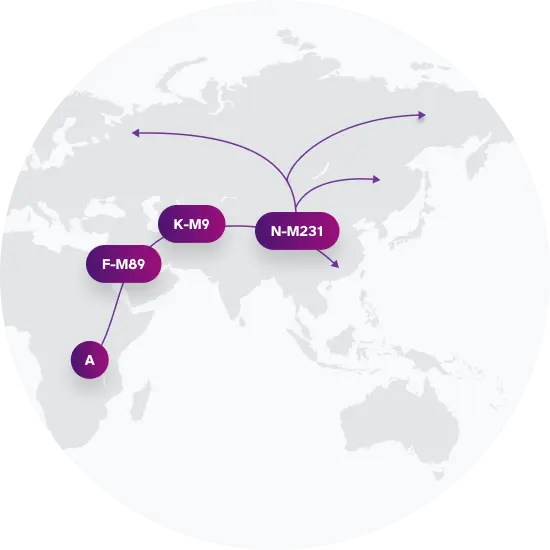Haplogroup N-L665
What is Paternal Haplogroup N-L665?
Haplogroup N-L665, also known as Haplogroup N-M231 (Y Chromosome Consortium long-form label), is a genealogical group of lineages defined by unique genetic markers present on the Y-chromosome. Your paternal haplogroup, or that of your father if you do not have a Y-chromosome, paints a picture of your ancient origins and the migrations of your ancestors. Although your paternal haplogroup reflects just one of your many ancestral lineages, it carries information about that lineage over tens of thousands of years.
Haplogroup N-L665 is descended from haplogroup N-M231. Among 23andMe research participants, haplogroup N-L665 is commonly found among populations in China and Taiwan.
It's important to note that your haplogroup doesn't define your current ethnic identity; rather, it provides an insight into your deep ancestry on the paternal side.
 Paternal Haplogroup Origins N-M231
Paternal Haplogroup Origins N-M231Top Surnames with Haplogroup N-L665
For surnames with sufficient representation in the data, these percentages represent the frequency with which each surname is found in individuals exhibiting this genetic marker.
Haplogroup N-L665 is linked to the people of the lower Xiajiadian culture
Remains from three humans found at a site called Dadianzi in the Inner Mongolian Autonomous Region of China, belonged to haplogroup N-M231. The Dadianzi site was dated to 3,600 years old, and it also contained pottery, bronze artifacts, and burial rituals. The artifacts are from a period called the Lower Xiajiadian culture, which was a main branch of the bronze culture of northern China 4,500-3,500 years ago, primarily practiced in the West Liao-River valley. This wealthy civilization had highly developed agriculture, unique painted pottery, and other elaborate artifacts. The human remains found at Dadianzi indicate that haplogroup N-M231 made up a large proportion of the Lower Xiajiadian culture population, perhaps as far back as 12,000 years ago in northern China.

